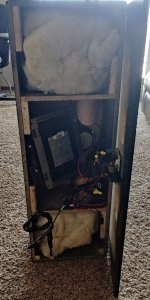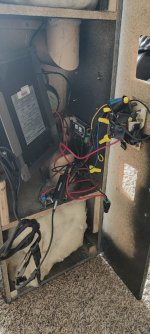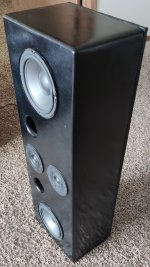This is my project I did, done while I was in college and on a budget. As such I had little tools and workspace but given the means I think it came out well. I hope to continue to expand and grow this project because it was a lot of fun. For starters this project uses a set of 8in Alesis full range speakers and two 4in tweeters (from the previous full range). I harvested these from old bookshelf speakers. The box I designed and built myself out of particle board. For the amp I used a car amp and then to be able to get media to stream I used a "Up2Stream Pro V3 - Multiroom Wireless Receiver Board (No Amp)". I then built it in such a way that it actually uses an ATV battery, providing at minimum 10 hours of use before needing a recharge.

The idea I had behind this was to get it so the speaker was not just a speaker for in the house, but more importantly one that could be used on the go. I realize this is significantly larger than typical portable speakers, but eventually I will build smaller.

For the two full range drivers I ported using cardboard tubing, and then proved insulation in each speaker chamber. This came about after some trial and error and just playing around with what sounded better and reduced interference.
For the wiring like previously stated I used a car amp that allowed me to separate into left and right channel and also full range and high range. This amp was the second choice of amp I made because I had issues with several amp boards being overloaded due to wiring issues. The Arylic board I used I have done things with their products in the past and liked how I would get several input options: from Wi-Fi and Bluetooth to aux line in. In order to make this board work I used a voltage converter to reduce from standard ATV battery 12V to 5V. I encountered a number of problems from there, one of which was some feedback coming through the ground. I found a ground loop Isolator significantly reduced this problem to the point it is only noticeable at very high volumes.

On the box I did go for the black because I was hoping for a piano black finish, but due to time constraints and poor working areas, I did not get the high gloss mirror finish I was hoping for, but it still turned out okay. I have been using this build for over a year now and have had a blast. At first, I heavily used the Wi-Fi and Bluetooth features of the Arylic board, but now that I am in a more permanent space, I have linked this speaker via auxiliary cable with another arylic product to provide a more immersive sound in all points of the room. I use it with music, movies, and TV. What do you think? What ideas do you have?


The idea I had behind this was to get it so the speaker was not just a speaker for in the house, but more importantly one that could be used on the go. I realize this is significantly larger than typical portable speakers, but eventually I will build smaller.

For the two full range drivers I ported using cardboard tubing, and then proved insulation in each speaker chamber. This came about after some trial and error and just playing around with what sounded better and reduced interference.
For the wiring like previously stated I used a car amp that allowed me to separate into left and right channel and also full range and high range. This amp was the second choice of amp I made because I had issues with several amp boards being overloaded due to wiring issues. The Arylic board I used I have done things with their products in the past and liked how I would get several input options: from Wi-Fi and Bluetooth to aux line in. In order to make this board work I used a voltage converter to reduce from standard ATV battery 12V to 5V. I encountered a number of problems from there, one of which was some feedback coming through the ground. I found a ground loop Isolator significantly reduced this problem to the point it is only noticeable at very high volumes.

On the box I did go for the black because I was hoping for a piano black finish, but due to time constraints and poor working areas, I did not get the high gloss mirror finish I was hoping for, but it still turned out okay. I have been using this build for over a year now and have had a blast. At first, I heavily used the Wi-Fi and Bluetooth features of the Arylic board, but now that I am in a more permanent space, I have linked this speaker via auxiliary cable with another arylic product to provide a more immersive sound in all points of the room. I use it with music, movies, and TV. What do you think? What ideas do you have?

I think its very puzzling.
You broke some rules, like two tweeters sideways is big nono, tweeter far from midbass for some reason.
Is this one speaker? MTTM? Or two stereo bookshelfs on top of each other in stereo?
Do you like the sound effect it produces?
You broke some rules, like two tweeters sideways is big nono, tweeter far from midbass for some reason.
Is this one speaker? MTTM? Or two stereo bookshelfs on top of each other in stereo?
Do you like the sound effect it produces?
Hey that is good to know. Why is that?I think its very puzzling.
You broke some rules, like two tweeters sideways is big nono, tweeter far from midbass for some reason.
Is this one speaker? MTTM? Or two stereo bookshelfs on top of each other in stereo?
Do you like the sound effect it produces?
As your first question, it is 2 stereo bookshelf's on top of each other in stereo. in these pictures I posted I have the box vertical, but it is/was designed to lay it down horizonal. thus creating a more left and right channel. (I get this does not solve the two tweeters next to each other, but I was also trying to leave room for adding more speakers in the future.)
For the second question: yes, I do like the sound for now, but would like to use this as a stepping stone to better.
My budget was $150. I think I went just over that because I spent extra on paint.How much did you spend on the project?
What kind of crossover did you use? Did you simulated or measured the response? What are those weird ports inside? How did you calculate bassreflex size/length?
after checking your post and also checking the Arylic website, then I have a question about the power supply. I know on their website, the package does not include the power supply, so I want to know whether can I use the power supply that sold on their website
So, this project is me just getting into the designing and building and as such these question are mostly making me realize I need to do lots more research. With that in mind with the Arylic boards the company has designed a ACPWorkbench tool for windows in which you can adjust many settings like crossover. As for "those weird ports" I am guessing you are referring to the back panel; those square "ports" were from an early design feature that I since removed due to the problem of interference and feedback and have yet to cover; however, I am exploring a few creative options for them. Lastly as for the bass reflex calculation, I did not calculate, I played with design and what sounded good to the ear. Sorry this is a whole lot less technical then you were probably hoping for.What kind of crossover did you use? Did you simulated or measured the response? What are those weird ports inside? How did you calculate bassreflex size/length?
Simple answer is: yes, their power supply (<--link to their power supplies) should work, you just need to check to make sure you order the right input voltage for the board you are using and from what I can see the correct country for outlet side. With that answer in mind I feel important to note it depends on the use of the board. The Arylic PSU's are fine (from my experience), but as one can see with a project like this I did not want to have to plug in power to several boards so finding a way to supply power to everything with one cord was important to me.after checking your post and also checking the Arylic website, then I have a question about the power supply. I know on their website, the package does not include the power supply, so I want to know whether can I use the power supply that sold on their website
I just checked arylic website, they had a lot diy board, will you use other one for integration in the future? Looking forward to...
Very interesting project! I would like to know how the sound quality is in WiFi mode, and I have ceiling speakers in my living room and kitchen that I would like to try to connect to their product. If I both come to connect their products, how long is their delay for this multi-room feature?
Wow, I didn't know such cost-effective way for speaker project 🙂 I'm interested in it!
When will you post some more pics of your diy new speakers, I expect that.
When will you post some more pics of your diy new speakers, I expect that.
Hi there, It's so great to be able to use it with the battery. How did you connect it to the battery? And how do you play music when using it outdoors, without wifi or LAN? Does it support USB sticks?
Yeah, since this project I have used their sub board, and I am working on serval other projects with some of their DIY boards.I just checked arylic website, they had a lot diy board, will you use other one for integration in the future? Looking forward to...
Their software supports .flac so I have found I prefer using Wi-Fi over Bluetooth because the audio quality seems to be better.Very interesting project! I would like to know how the sound quality is in WiFi mode, and I have ceiling speakers in my living room and kitchen that I would like to try to connect to their product. If I both come to connect their products, how long is their delay for this multi-room feature?
If I am understanding the situation you're talking about right, once you link to two audio zones (kitchen and living room) in their app then via Wi-Fi the two areas play simultaneously without delay from each other. So, for music I find it great, but if you have it connected to your tv for tv and movies there is a slight delay (maybe .5 second) from the picture when using Wi-Fi to connect the boards. The way I have gotten around this is by feeding aux cable to both devices and linking them that way to the tv for no lag between picture and audio. (The delay I have found comes from the processing the sync between two arylic devices, so they play together. Once again not a problem with just audio but a bit annoying for movies/tv.)
Great questions! For the battery I used a trickle charger to keep it charged (One can see it mounted to the backboard in my pictures). Then as I stated in my description, I used a voltage converter to reduce from the 12V ATV battery charge down to 5V for the arylic board. Then my amp was a car amp so it was made to run off of 12V batteries. Does that make sense?Hi there, It's so great to be able to use it with the battery. How did you connect it to the battery? And how do you play music when using it outdoors, without wifi or LAN? Does it support USB sticks?
For music on the go: The arylic boards in the Wi-Fi settings in the app allow you to always broadcast a Wi-Fi signal so I can use its signal outdoors to play. Then the board also has Bluetooth. Then depending on the board, in my case above the board I used from arylic has Aux in and USB-A in. It is for this variety of connection options I used the board I did (linked to in original post).
I would like to post my sub I built; I fell I did a better job with it. The only problem is I don't have it with me right now and need to get it from my storage unit in another state.Wow, I didn't know such cost-effective way for speaker project 🙂 I'm interested in it!
When will you post some more pics of your diy new speakers, I expect that.
- Home
- Loudspeakers
- Multi-Way
- My DIY speaker project
